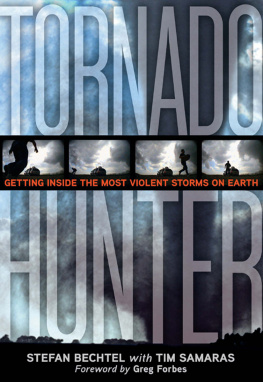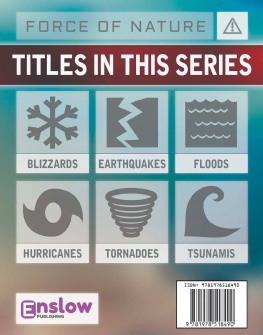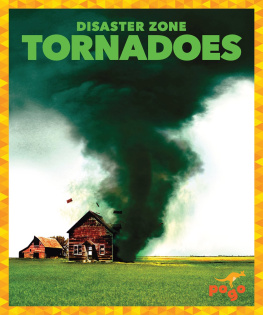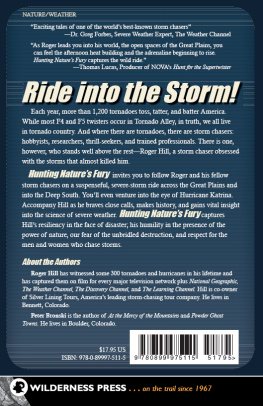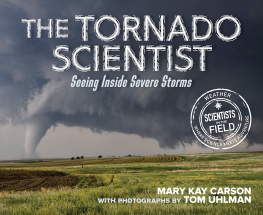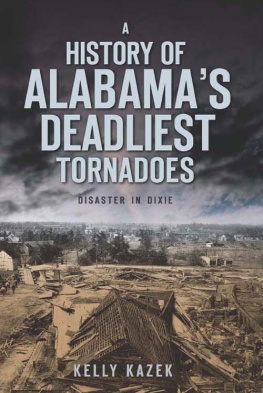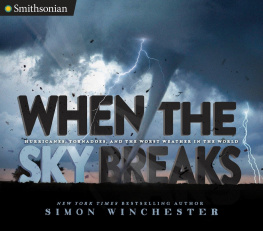TORNADO HUNTER
GETTING INSIDE THE MOST VIOLENT STORMS ON EARTH
Stefan Bechtel with Tim Samaras
Foreword by Greg Forbes

WASHINGTON, D.C.

Founded in 1888, the National Geographic Society is one of the largest nonprofit scientific and educational organizations in the world. It reaches more than 285 million people worldwide each month through its official journal, National Geographic, and its four other magazines; the National Geographic Channel; television documentaries; radio programs; films; books; videos and DVDs; maps; and interactive media. National Geographic has funded more than 8,000 scientific research projects and supports an education program combating geographic illiteracy.
For more information, please call 1-800-NGS LINE (647-5463) or write to the following address:
National Geographic Society
1145 17th Street N.W.
Washington, DC 20036-4688 U.S.A.
www.nationalgeographic.com
For rights or permissions inquiries, please contact National Geographic Books Subsidiary Rights: ngbookrights@ngs.org
Published by the National Geographic Society
Copyright 2009 Tim Samaras and Stefan Bechtel
All rights reserved. Reproduction of the whole or any part of the contents without written permission from the publisher is prohibited.
Library of Congress Cataloging-in-Publication Data
Bechtel, Stefan.
Tornado hunter getting inside the most violent storms on Earth / Stefan Bechtel with Tim Samaras; foreword by Greg Forbes.
p. cm.
Includes bibliographical references and index.
ISBN: 978-1-4262-0580-4
1. TornadoesUnited States. 2. Storm chasersUnited StatesAnecdotes. I. Samaras, Tim. II. Title.
QC955.5.U6B427 2009
551.553dc22
2009000724
Illustrations Credits
Cover: (Background), Gene Rhoden/Weatherpix Stock Images
Interior: All photographs by Timothy Samaras unless otherwise noted: Carsten Peter; Robert Clark; Rich Thompson/Twistex; Courtesy Dave Hoadley; Carsten Peter; Ted Fujita; AP/Wide World Photos; Ted Fujita; Ted Fujita; Carsten Peter.
Insert: 1 (UP), Carsten Peter; 1 (LO), Carsten Peter; 2 (UP), Carsten Peter; 2 (LO LE), Carsten Peter; 2 (LO RT), Carsten Peter; 3, Carsten Peter; 4-5, Timothy Samaras; 6, Timothy Samaras; 6-7, Jayson Prentice; 8 (UP), Rich Thompson/Twistex; 8 (LO), Jayson Prentice.
CONTENTS
Chapter 1
A HOLE IN THE SKY
Chapter 2
OUR PROBES STILL THERE!
Chapter 3
LOOKING FOR TROUBLE
Chapter 4
INTO THE CENTER OF THE CYCLONE
Chapter 5
TORNADO ON THE GROUND!
Chapter 6
A MILE-WIDE, SOD-SUCKING MONSTER
Chapter 7
THE BIG KAHUNA
Chapter 8
THE MAN WHO RODE THE THUNDER
Chapter 9
DOUGIE DOKKENS BIRTHDAY CAKE
Chapter 10
THE MYSTERY OF FLIGHT 66
Chapter 11
A LIFE-THREATENING SITUATION
Chapter 12
CALLING ALL TORNADO CHASERS
Chapter 13
GLOBAL WARMING AND TORNADOES
Chapter 14
YOUR TEN-SECOND GETAWAY PLAN
Chapter 15
PASSION AND PURPOSE
FOREWORD
THE UNITED STATES HAS MORE TORNADOES THAN ANY OTHER COUNTRY IN THE world. Youve seen videos of them and the destruction they cause. What you might not realize is just how many people actually make storm chasing their hobby. Each February a National Storm Chasers Convention is held in Denver, Colorado. Ive given talks at several of them, and was amazed that over 200 chasers were in attendanceand thats only a fraction of the number of people who chase storms. Sometimes there may be as many as three dozen chasers following the same thunderstorm! Chasers arent confined to the Midwest but emanate from most parts of the United States and even from other countries, some making their summer vacation a trip to Tornado Alley. There are even several storm-chase tour companies that take paying customers on the experience of a lifetime.
Chasers love the challenge of predicting where severe storms will develop, then navigating themselves into position to photograph the storm andthe ultimate goalits tornado. Many enjoy the thrill of getting close enough to almost feel the tornado winds, yet escaping when the danger is deemed too great. Tornado Hunter weaves the fascinating tales of several veteran storm chasers.
Besides capturing tornadoes on video, many storm chasers provide a valuable service as storm spotters, calling the National Weather Service with ground truth that there is actually a tornado in progress in association with the rotation that has been spotted by Doppler radar. A few chasers actually make scientific measurementseither using mobile Doppler radars or with other instrumentation. Their efforts really help the meteorology community learn more about tornadoes and severe thunderstorms.
One of the most remarkable accomplishments in meteorology is to be able to make measurements of a tornado. They are tiny in comparison with most weather systems, difficult to pinpoint, and often fast-moving, and they tend to destroy any conventional measuring instruments in their path. But these hurdles dont stop one veteran chaserTim Samaras! He developed special equipment to collect observations in tornadoes, manages to place these instruments in the paths of tornadoes, and then retreats to a safe distance to collect video of the tornadoes in progress. Tornado Hunter tells us how he does it and shares tales of adventure along the way.
Tim Samaras is one of the storm chasers I respect the most. I have the deepest respect for his vision and scientific and engineering skills in development of the turtle instrument and video instrumentation and for his courage in placing these instruments in the path of rapidly approaching tornadoes. This gives the meteorological community the opportunity to learn things about the near-surface character of tornadoes that are not gathered in any other way, and greatly complements information gathered from mobile Doppler radars and by other storm chasers.
Tornado Hunter intertwines fascinating tales of storm chasingfrom some of the most memorable and destructive tornadoes in recent yearswith stories of the history of the studies of thunderstorms, lightning, and tornadoes. It describes what weather conditions chasers look forthose that allow thunderstorms to become severe and tornadic. It should be captivating reading for anyone interested in or concerned about tornadoesespecially those who prefer to get the thrill of the chase vicariously!
Greg Forbes
INTRODUCTION
AND GOD SAID TO ELIJAH: GO FORTH AND STAND UPON THE MOUNT BEFORE the Lordand a great and strong wind rent the mountainsbut the Lord was not in the wind. These words from Kings 19:11 were spoken at a service held for the small town of Barneveld, Wisconsin, after a devastating F5 tornado struck the community a year earlier, during the early morning hours of June 8, 1984. The spoken words were captured by a documentary camera and became the opening lines for the Tornado! episode in the PBS television series NOVA, released in 1985.
The documentary showed meteorologist Howie Bluestein explaining in very simple terms how tornadoes form, and a rather young Louis Wicker (now a research scientist at the National Severe Storms Laboratory) leading a team of brave students trying to deploy a 400-pound data-measuring device called TOTO in the paths of tornadoes. These scientists turned my flame of passion for the weather into a raging bonfire of obsession. Their work showed me that there were indeed scientists actively pursuing research on tornadoes and thunderstorms, and as soon as I could, I became a storm chaser.

